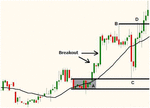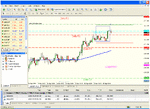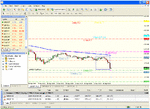You are using an out of date browser. It may not display this or other websites correctly.
You should upgrade or use an alternative browser.
You should upgrade or use an alternative browser.
Is there any particular reason your box is 3 hours?
It seems that this is the hardest question :whistling . Actually I do not know why, I just thought this range is good enough for morning breakout. The variations could be session's breakout and daily breakout. That is what I've been testing for a while and the results for me are not perfect but good enough to continue trading this strategy. Also, the reason its 3 hours is because that is what has worked, you want enough time to get a good range of high/lows so that you don't get stopped out all the time when a fakeout happens.
Last edited:
04.09.2009
Good Morning
Today is a friday, the end of my first week trade monitoring here. GBPJPY was a bit slow yesterday and it seems that it is a slackness before a storm (NFP - Change in the number of employed people during the previous month, excluding the farming industry). These data can affect GBPJPY to move for a few hundred pips in a few seconds. At the moment I have 4 pending orders:
Trades for today:

Update: I decided to delete my pending orders for today because there is no PA today both opening of Frankfurt and London are calm and I will not risk today.
Week Result:
We have +270pips
Enjoy the weekend and see you all next week.
Good Morning
Today is a friday, the end of my first week trade monitoring here. GBPJPY was a bit slow yesterday and it seems that it is a slackness before a storm (NFP - Change in the number of employed people during the previous month, excluding the farming industry). These data can affect GBPJPY to move for a few hundred pips in a few seconds. At the moment I have 4 pending orders:
Trades for today:
Update: I decided to delete my pending orders for today because there is no PA today both opening of Frankfurt and London are calm and I will not risk today.
Week Result:
We have +270pips
Enjoy the weekend and see you all next week.
Last edited:
Last edited:
london_lad
Established member
- Messages
- 675
- Likes
- 1
Why do you put two trades in same direction? I thought you had to put 2 trades in either direction?
Also, what is your rule about EMA95? if price is above, go long only? and vice versa? and when EMA95 is in the box, then go both ways?
Also, what is your rule about EMA95? if price is above, go long only? and vice versa? and when EMA95 is in the box, then go both ways?
london_lad
Established member
- Messages
- 675
- Likes
- 1
Yesterday was a fakeout on GBP/JPY 🙁 Nevermind. Just one more thing, do you cancel your orders if they haven't kicked in for about 2 to 3 hours?
hi,Yesterday was a fakeout on GBP/JPY 🙁 Nevermind. Just one more thing, do you cancel your orders if they haven't kicked in for about 2 to 3 hours?
Yes, everything correct about EMA. Concerning two orders, I used to do so because I have two TP. You can go with double lot and when TP1 reached close half of it. If my orders not triggered till 11/00GMT. I cancel all of them. If I have orders in both directions and one direction orders triggered, I cancel other direction orders. Yesterday was a fakeout, I have not tested yet, cause I do not have time to do it. I wonder maybe it is necessary to add the rule to open trade when the bar closed under or above the box breakout?
breakout
I have found nice article about breakouts. The author is Sam Seiden.
Most traders seem to let emotion complicate what can really be a simple, rule based, and very profitable strategy. Trading breakouts can be high risk, high stress, low reward, and low probability or this strategy can be low risk, low stress, high reward, and high probability. The difference lies in how you enter into this type of position.
Before getting into the details of the strategy, it’s important to understand two key components of markets.
1. Why do prices move in any market? Price in any market turns at price levels where demand and supply are out of balance. The consistently profitable trader is able to identify a demand and supply imbalance which means knowing where the REAL buyers and sellers are in a market.
2. Who is on the other side of your trade? Trading is simply a transfer of accounts from those who don’t know what they are doing into the accounts of those who do. The consistently profitable trader makes sure a novice trader is on the other side of their trades.
The Logic
Notice area “A” in Figure 1 below. Area “A” is the origin of a strong rally in price. Most breakout traders will look to buy as price breaks out to the upside from area “A”. This type of breakout entry is typically the “sucker bet”. Traders see price moving higher from area “A” and they give in to emotion and buy into that initial rally. The problem is that by the time you buy the breakout of area “A”, price has moved so far that it becomes a high risk and low reward trade. Instead, I sit back and let the breakout happen because that breakout tells me that there is a demand and supply imbalance at area “A”, this is exactly where the buyers are. Next, I wait for price to return to area “A”. When it does at “C”, I am a very interested buyer as I am confident I am buying from a novice seller. I know this because the seller at “C” is making the two mistakes that every consistent losing (novice) trader makes. First, they are selling after a period of selling and second, they are selling at a price level where demand exceeds supply.

The Setup
For longs, identify a market in an uptrend by using a 20 period moving average. Next, identify the origin of a strong move and draw two lines around the price action to create a demand zone (area “A”). Make sure the demand level has the pattern “Drop-Base-Rally” as that is key. In other words, area “A” should be preceded by a decline in price which makes it higher probability. Then, make sure there is a significant profit margin (profit target). This would be the distance from area “A” to “B”, the highest high of the initial breakout before price returns to “A” at “C.”
The Action
Buy at “C” when price touches the top black line and place your protective sell stop just below the lower black line. Adjust your position size so that you are not risking more than you are willing to lose. Place your profit target based on the high of the initial breakout “B” which in this case would have you selling for a profit at “D.”
The Breakout: Two types of entries, very different odds.

The Breakdown: Two types of entries, very different odds

The proper breakout entry works in any market and any time frame. A key component to making these work that is beyond the scope of this article is this: When taking any buy or sell entries in markets, make sure you know exactly where price is with regard to the larger time frame supply / demand curve. Whether you trade Stocks, Futures, Forex, or Options, understand that behind all the candles on your screen in all these markets are people and their emotions. Most will fall for the emotional trading traps set by fear and greed, others get paid from this novice group.
I have found nice article about breakouts. The author is Sam Seiden.
Most traders seem to let emotion complicate what can really be a simple, rule based, and very profitable strategy. Trading breakouts can be high risk, high stress, low reward, and low probability or this strategy can be low risk, low stress, high reward, and high probability. The difference lies in how you enter into this type of position.
Before getting into the details of the strategy, it’s important to understand two key components of markets.
1. Why do prices move in any market? Price in any market turns at price levels where demand and supply are out of balance. The consistently profitable trader is able to identify a demand and supply imbalance which means knowing where the REAL buyers and sellers are in a market.
2. Who is on the other side of your trade? Trading is simply a transfer of accounts from those who don’t know what they are doing into the accounts of those who do. The consistently profitable trader makes sure a novice trader is on the other side of their trades.
The Logic
Notice area “A” in Figure 1 below. Area “A” is the origin of a strong rally in price. Most breakout traders will look to buy as price breaks out to the upside from area “A”. This type of breakout entry is typically the “sucker bet”. Traders see price moving higher from area “A” and they give in to emotion and buy into that initial rally. The problem is that by the time you buy the breakout of area “A”, price has moved so far that it becomes a high risk and low reward trade. Instead, I sit back and let the breakout happen because that breakout tells me that there is a demand and supply imbalance at area “A”, this is exactly where the buyers are. Next, I wait for price to return to area “A”. When it does at “C”, I am a very interested buyer as I am confident I am buying from a novice seller. I know this because the seller at “C” is making the two mistakes that every consistent losing (novice) trader makes. First, they are selling after a period of selling and second, they are selling at a price level where demand exceeds supply.

The Setup
For longs, identify a market in an uptrend by using a 20 period moving average. Next, identify the origin of a strong move and draw two lines around the price action to create a demand zone (area “A”). Make sure the demand level has the pattern “Drop-Base-Rally” as that is key. In other words, area “A” should be preceded by a decline in price which makes it higher probability. Then, make sure there is a significant profit margin (profit target). This would be the distance from area “A” to “B”, the highest high of the initial breakout before price returns to “A” at “C.”
The Action
Buy at “C” when price touches the top black line and place your protective sell stop just below the lower black line. Adjust your position size so that you are not risking more than you are willing to lose. Place your profit target based on the high of the initial breakout “B” which in this case would have you selling for a profit at “D.”
The Breakout: Two types of entries, very different odds.

The Breakdown: Two types of entries, very different odds

The proper breakout entry works in any market and any time frame. A key component to making these work that is beyond the scope of this article is this: When taking any buy or sell entries in markets, make sure you know exactly where price is with regard to the larger time frame supply / demand curve. Whether you trade Stocks, Futures, Forex, or Options, understand that behind all the candles on your screen in all these markets are people and their emotions. Most will fall for the emotional trading traps set by fear and greed, others get paid from this novice group.
hi
Please read my post #19 . I hope I answered your question. 🙂
Interesting thread, but why have you chosen GBPJPY?
Please read my post #19 . I hope I answered your question. 🙂
Soondoock ,
Could you please take a screen shot of the pairs , and comment these pointing out the boxes, and where you are putting your entries and exit. This would make it much easier to understand your entries and exit.
Ok I will, 🙂
15.09.2009
Good Morning,
Below you can see a chart with my current setup, as you can see MA is below the BOX, so we have only Buy orders.

As you can see, at the moment, the price went too far away form my buystop orders. And I think it won't come back today, anyway I will wait till 15-00GMT to delete my orders.
Orders deleted. No trade for today. See you all tomorrow.
Have a nice day!
Good Morning,
Below you can see a chart with my current setup, as you can see MA is below the BOX, so we have only Buy orders.

As you can see, at the moment, the price went too far away form my buystop orders. And I think it won't come back today, anyway I will wait till 15-00GMT to delete my orders.
Orders deleted. No trade for today. See you all tomorrow.
Have a nice day!
Last edited:
Thank you.
This makes it much easier to follow.
How did you choose how many ticks away from the box you'll use?
How did you choose your exit prices ( winning & losing )?
I use my EA for this strategy. So the exit price depends on time, EA close all the positions at 16.00GMT and I have always SL 75pips and TP1-50pips TP2-100pips. I place my orders 7pips away from box.
Similar threads
- Replies
- 11
- Views
- 4K

